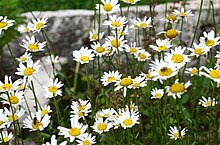| Leucanthemum ircutianum | |
|---|---|

| |
| Scientific classification | |
| Kingdom: | Plantae |
| Clade: | Tracheophytes |
| Clade: | Angiosperms |
| Clade: | Eudicots |
| Clade: | Asterids |
| Order: | Asterales |
| Family: | Asteraceae |
| Genus: | Leucanthemum |
| Species: | L. ircutianum |
| Binomial name | |
| Leucanthemum ircutianum (Turcz.) DC., 1838 | |
| Synonyms | |
| |
Leucanthemum ircutianum is a herbaceous perennial plant species in the family Asteraceae, that can be found growing in Eurasian (mostly European) countries and North America. Just like the similar L. vulgare, it is commonly known as the oxeye daisy.
Taxonomy
Species name and the first formal description were given to this plant by Swiss botanist Augustin Pyramus de Candolle in year 1838.
Even though taxonomy of this species and related taxa is complicated, there are currently three recognized subspecies:
- Leucanthemum ircutianum subsp. asperulum (N.Terracc.) Vogt & Greuter
- Leucanthemum ircutianum subsp. ircutianum
- Leucanthemum ircutianum subsp. leucolepis (Briq. & Cavill.) Vogt & Greuter
Some authors list additional two subspecies:
- Leucanthemum ircutianum subsp. cantabricum (Sennen) Vogt
- Leucanthemum ircutianum subsp. crassifolium (Lange) Vogt
Description
This upright-growing herbaceous perennial daisy can reach from 20 to 80 centimetres of height. Its stem is usually firm, covered with short trichomes and only rarely spread out. Alternately arranged leaves are simple, they are sessile (without leafstalk) and serrated or shallowly lobed, while being lanceolate to spatulate in shape. There are no stipules.
Like other species of the family Asteraceae, L. ircutianum has flowers united into so-called pseudanthium (calathidium), with outer layer consisting of multiple whiteish strap-shaped ray flowers and inner area being of numerous yellowish circular-shaped tiny disc flowers. Bracts are present; the inflorescence is surrounded with lanceolate involucral leaves. Calyx is modified into a pappus.
This species ovary is inferior. Seed is enclosed into a brown dry fruit that is called an achene (more specifically cypsela). L. ircutianum is an entomophilous species, that attracts various insect pollinators with its big and noticeable inflorescences that imitate a single flower. This daisy flowers between May and October.
Similar species
Species L. ircutianum is very similar to L. vulgare. Besides some morphological (such as size, pollen) and ecological differences (eg. flowering time, type of habitats), species also differ in their genome, with L. ircutianum being tetraploid and L. vulgare exhibiting diploidy. They have mostly similar distribution area in Europe, but L. vulgare is more common in North America. In Canada, where both daisies can be found growing, L. ircutianum occurs primarily in the east parts of the country.
Distribution and habitat
The oxeye daisy is a plant of Eurasia (mostly Europe, with some parts of Asia) and North America. European countries that fall into species' distribution area are Germany, France, former Soviet Union, Spain and Italy, as well as Albania, Austria, Baltic States, Belgium, Bulgaria, Finland, Great Britain, Portugal, Romania, Sardinia, Sicily, Sweden, Switzerland and former Yugoslavian countries. In America L. ircutianum can be found in both USA and eastern parts of Canada.
This daisy flower usually grows in various habitats, including some anthropologically modified urban areas. Commonly the species can be found on different meadows, forest edges, near paths and roads, as well as in various other ruderal landscapes.
The Raunkiær system classifies it as a hemicryptophyte species.
Gallery
References
- ^ "Leucanthemum ircutianum (Turcz.) DC". www.gbif.org. Retrieved 2021-09-05.
- ^ "Navadna ivanjščica - Urbanatura". www.urbanatura.si (in Slovenian). Retrieved 2021-09-05.
- "Leucanthemum ircutianum DC., Oxeye daisy (Provence, France)". Pl@ntNet. Retrieved 2021-09-05.
- ^ "Leucanthemum ircutianum DC. | Plants of the World Online | Kew Science". Plants of the World Online. Retrieved 2021-09-05.
- ^ Data: Leucanthemum ircutianum Pladias – Database of the Czech Flora and Vegetation. www.pladias.cz. Retrieved 5. September 2021.
- "Leucanthemum ircutianum (navadna ivanjščica)". www.botanicni-vrt.si (in Slovenian). Retrieved 2021-09-05.
- "Leucanthemum ircutianum". sloveniahiking.rocks. Retrieved 2021-09-05.
- ^ "Leucanthemum vulgare (oxeye daisy)". www.cabi.org. Retrieved 2021-09-05.
- Bährle-Rapp, Marina (2007), "Chrysanthemum leucanthemum", Springer Lexikon Kosmetik und Körperpflege, Berlin, Heidelberg: Springer Berlin Heidelberg, p. 106, doi:10.1007/978-3-540-71095-0_1947, ISBN 978-3-540-71094-3, retrieved 2021-09-05
- ^ Clements, David R.; Cole, Dan E.; King, Jane; McClay, Alec (2004-01-01). "The biology of Canadian weeds. 128. Leucanthemum vulgare Lam". Canadian Journal of Plant Science. 84 (1): 343–363. doi:10.4141/p02-112. ISSN 0008-4220.
External links
 Data related to Leucanthemum ircutianum at Wikispecies
Data related to Leucanthemum ircutianum at Wikispecies Media related to Leucanthemum ircutianum at Wikimedia Commons
Media related to Leucanthemum ircutianum at Wikimedia Commons
| Taxon identifiers | |
|---|---|
| Leucanthemum ircutianum |
|






